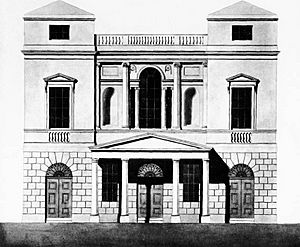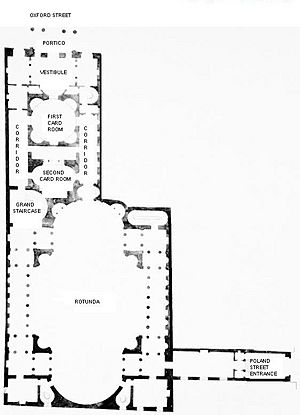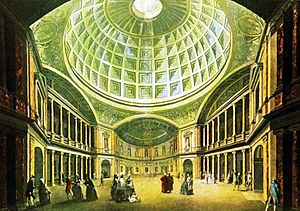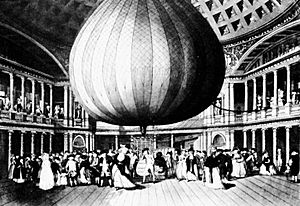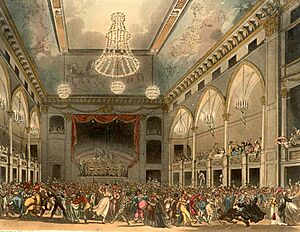Pantheon, London facts for kids
The Pantheon was once a very popular and fancy building in Oxford Street, London, England. It was a place where people could go for fun and entertainment. Designed by James Wyatt, it first opened its doors in 1772. The main part of the building, called the rotunda, was a huge circular room with a big dome on top, a bit like the famous Pantheon in Rome.
At first, it was used as a grand meeting place during the winter social season. Over the years, it changed its purpose several times, becoming a theatre, then a market (bazaar), and later a showroom for a wine merchant. The original building was taken down in 1937. Today, a Marks and Spencer store stands on the same spot at 173 Oxford Street.
Building the Pantheon
The idea for the Pantheon came from a man named Philip Elias Turst. In 1769, he got hold of a piece of land on Oxford Street. He wanted to build a new, grand entertainment spot for the winter, similar to the popular Ranelagh Gardens which was open in the summer.
He needed money for this big project. He sold 50 shares in the business, each costing £500. This raised £25,000, and construction started in mid-1769.
The architect chosen for the Pantheon was James Wyatt. He was very young, only 22 or 23, and not well-known at the time. However, he later became one of Britain's most famous architects. His older brother, Samuel Wyatt, was the main builder for the project.
Many skilled artists and craftspeople worked on the Pantheon. These included Joseph Rose, who did the plasterwork, and Joseph Nollekens, a sculptor who made four statues. An organ was also built for the building by John Stretzle. The Pantheon was finished in January 1772.
Inside the Grand Building
The Pantheon had a grand entrance on Oxford Street, with a covered walkway called a portico. This led into a large entrance hall. From there, you could go to the main staircase or directly into the huge assembly room, known as the rotunda. The whole building was quite deep and wide.
The most impressive part was the rotunda, a large square space topped with a beautiful domed ceiling. It had columns on the sides, creating aisles and galleries on the first floor. The design and decorations inside were inspired by ancient Roman buildings. Below the rotunda, there was another large room used for tea and supper.
Many people who saw the Pantheon thought it was incredibly beautiful. Horace Walpole, a famous writer, even said it was "the most beautiful edifice in England." Dr. Burney, another writer, described it as "the most elegant structure in Europe, if not on the globe."
The cost of building the Pantheon was a lot of money for the time. It cost about £36,965. This included the main construction, a secondary entrance, and all the furniture, paintings, statues, and the organ.
History of the Pantheon
The Pantheon officially opened on Monday, January 27, 1772. It was a huge event! Tickets for the first night were very expensive, and over 1,700 important people attended, including ambassadors and dukes and duchesses.
At first, the Pantheon was a very fashionable place. It held assemblies (gatherings) three times a week, without dancing or music. Later, they added masquerades (masked balls) and concerts. For a while, the shares in the business were worth a lot of money.
However, by the 1780s, the Pantheon became less popular. In 1784, it hosted a concert celebrating the music of the German composer Handel.
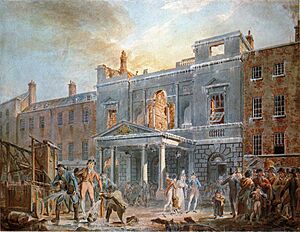
In 1789, a theatre called the King's Theatre burned down. So, the Pantheon was changed into an opera house. James Wyatt was again the architect for this change. But after only one full season of opera, the Pantheon itself was destroyed by fire in 1792. A famous painting, possibly by a young J. M. W. Turner, shows the building the morning after the fire.
By 1795, the Pantheon was rebuilt, looking similar but not exactly the same. It reopened for masquerades and concerts. However, this new version of the assembly rooms was not successful.
From 1798 to 1810, the owners tried to manage the Pantheon themselves, but its popularity kept going down. In 1811–12, the building was changed into a theatre by Nicholas Wilcox Cundy. But strict rules from the government official who controlled theatres meant this venture also failed. The Pantheon stopped being a place of public entertainment in 1814.
In 1833–34, the Pantheon was rebuilt again, this time as a large market called a bazaar. The architect was Sydney Smirke. Much of the old roof and walls were removed, but the main entrances on Oxford Street and Poland Street were kept. The new main space was a huge hall with a curved ceiling.
In 1867, a wine merchant company, W. and A. Gilbey, bought the building. They used it as offices and showrooms for many years, until 1937.
Soon after, the building was demolished to make way for a new Marks and Spencer store. The new Marks and Spencer building, designed by Robert Lutyens, opened in 1938. It has a shiny black granite front and is still a well-known building on Oxford Street. Because of its special history and design, it was given a special protected status in 2009.



